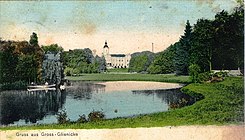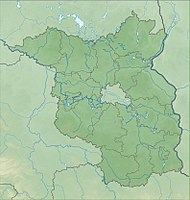Groß Glienicke manor park
| Groß Glienicke manor park | ||
|---|---|---|
| Park in Potsdam | ||

|
||
| View of the ponds with a line of sight to the manor house | ||
| Basic data | ||
| place | Potsdam | |
| District | Great Glienicke | |
| Created | approx. 1847/48 | |
| Technical specifications | ||
| Parking area | ? | |
|
52 ° 28 '32.1 " N , 13 ° 6' 56.8" E
|
||
The Groß Glienicke manor park is a landscape park originally belonging to the Groß Glienicke manor at the northern end of the Groß Glienicke lake . It was probably created in 1847/48 as an estate park for the manor house. This burned down in 1945. Since December 10, 2004 the manor park together with the Potsdamer Tor, the walls, the fountain and the grave complex of the Wollank family has been a listed building.
history
When the Landefeldt family took possession of the manor in 1836, the estate was expanded in several steps. Under Johann Heinrich Berger-Landefeldt, a mansion was built opposite the actual manor around 1847/48, which was embedded in a landscape park with the purchase of additional land. The layout of the park was based on the topographical conditions: In continuation of the glacial melt channel, in which the Groß Glienicker See also lies, the large pond was created with an island, while the western and eastern areas of the park are slightly elevated.
The spacious landscape park was traversed by two long lines of sight , the first of which ran from the manor house across the pond to Potsdamer Chaussee. The second and longer visual axis went from curiosity next to Potsdamer Tor through the entire park to further curiosity in the form of a monopteros , which stood at the opposite tip in the northeast of the facility at the intersection of the newly built Potsdamer Chaussee with the Ritterfelddamm.
The park was divided by light meadow areas and loose groups of coniferous and deciduous trees. The bank edge of the pond overgrown with water lilies was emphasized by large weeping willows. The path system mainly opened up the western area of the park and led with at least five bridges over the pond and on its island as well as over the inlet and outlet trenches. A former path, probably dating from the 18th century, has also been included in the path system.
In 1903 the Potsdamer Tor was made of concrete, which with its suspected open three-arched top shows a formal similarity to Bodo Ebhardt's design for a road bridge over the Rhine near Worms from 1895. In the western part of the park, the Wollank family, who had already acquired the estate in 1890, had their family grave built in 1917 in the form of a semicircular colonnade consisting of eight Doric columns , which opened towards the manor house. To the east of the grave there is a staffage building made of lime, field and brick in the form of a Gothic ruin with a brick well in front of the tower.
The manor park was completely preserved in its original form until the post-war period. When the border was drawn and the death strip was laid out after 1961, the park was divided into two parts and partially destroyed. A permanent campsite was created on the West Berlin side, while the tree population in the western area of the GDR within the exclusion zone remained untouched for decades. Today a section of the wall on the banks of the Groß Glienicker See reminds of the division.
Web links
- Entry in the monument database of the State of Brandenburg
- The Groß Glienicke manor park. Bulletin of the State Historical Association for the Mark Brandenburg e. V., Volume 106, No. 1, January 2005
- Experience report. In: unterwegs-in-Spandau.de
Individual evidence
- ↑ a b c The Groß Glienicke estate park. On the history of the manor. In: potsdam.de. State capital Potsdam, p. 2 , accessed on April 12, 2017 .
- ↑ Manor park under monument protection . In: Potsdam's latest news . January 8, 2005 ( online ).
- ↑ a b c The Groß Glienicke estate park. The landscape park. In: potsdam.de. State capital Potsdam, p. 3f. , accessed April 13, 2017 .
- ↑ a b c The Groß Glienicke estate park. Bulletin of the State Historical Association for the Mark Brandenburg e. V., Volume 106, No. 1, January 2005. P. 5 ff.





